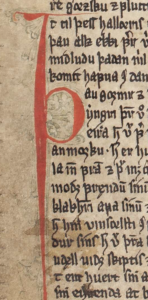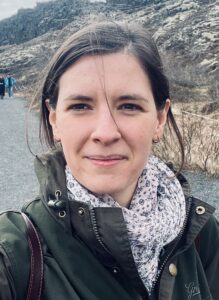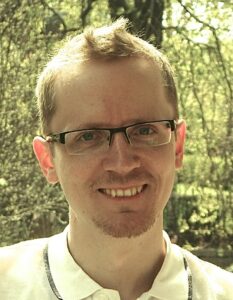Forn kveðskapur norrænn og bragarhættir
— Old Norse Poetry and Metrics
Málþing á vegum Miðaldastofu Háskóla Íslands — A University of Iceland Centre for Medieval Studies Symposium
Laugardaginn 21. júní 2025 kl. 14.00-17.00 — Saturday, June 21, 2025, at 14.00-17.00
Fyrirlestrasal Eddu (E103) — Edda auditorium (E103)
Dagskrá — Programme:
 14.00–14.30 Gudrun M. J. Samberger, Würzburg University: Nominal Word Formation in the Poetic Edda (GKS 2365 4to): The influence of metrics on etymology
14.00–14.30 Gudrun M. J. Samberger, Würzburg University: Nominal Word Formation in the Poetic Edda (GKS 2365 4to): The influence of metrics on etymology
14.30–15.00 Haukur Þorgeirsson, Árni Magnússon Institute: Cohesion in Germanic poetry
15.00–15.30 Bianca Patria, University of Oslo: Nýtask mér máltól: Allusive Art and Exegetical Thought in Einarr Skúlason’s Geisli
15.30–16.00 Kaffihlé — Coffee Break
16.00–16.30 Klaus Johan Myrvoll, University of Stavanger: The poetry of Gunnlaugs saga: a late thirteenth century patchwork?
16.30–17.00 Mikael Males, University of Oslo: How old are the oldest eddica minora?
Málþingið fer fram á ensku og er öllum opið. — The symposium will be conducted in English. All are welcome to attend.
Miðaldastofa Háskóla Íslands — The University of Iceland Centre for Medieval Studies
—o—o—o—
Gudrun M. J. Samberger
Nominal Word Formation in the Poetic Edda (GKS 2365 4to): The influence of metrics on etymology

This talk presents findings from my PhD thesis on nominal word formation in the Poetic Edda (GKS 2365 4to), focusing on the nominal suffix Proto-Germanic *-wandja- and its unique history in Old Norse, as well as related suffixes. My project explores nominal word formation through the study of etymologies of nouns containing the relevant suffixes. These studies lead to a deeper understanding of the function and semantics of the suffixes in question.
In the initiation of a study of etymologies in a corpus, it is imperative to first discern general nouns from other words that have undergone nominalisation in context. In some suffixes, such as the -nd-suffix that is attested in nouns of Proto-Germanic origins as well as in present participles that can be more recent formations, consideration of the literary context is necessary to differentiate ad-hoc formations from older nouns that may have been substantivized adjectives at some point. When studying corpora composed of metrical texts, considering the metrics of the attestation context plays a vital role for the interpretation of a word’s etymology.
An illustrative example is the case of gróandi. This noun is attested in Alvíssmál 10,5 only. Alvíssmál is a dialogue poem, almost entirely composed in ljóðaháttr. In stanza 9, Þór asks the dwarf Alvíss for the name of the earth used by different species. Alvíss answers (Alv. 10):
Jörð heitir með mönnum
En með álfum fold,
kalla vega vanir,
ígræn jötnar,
álfar gróandi,
kalla aur uppregin.
In this verse, due to the metre, gróandi must be a three-syllable noun that can denote the earth. The noun is transparently formed by building a present participle from gróa ‘to grow’ which is then nominalized. It is also conceivable that this may be a noun that has already been lexicalised. Nevertheless, several arguments suggest that the formation was ad-hoc: 1. The noun is not attested anywhere else with the same meaning. 2. In contemporary Icelandic, the noun gróandi does not continue the meaning ‘earth’ but rather means ‘growth period’. 3. In this particular context, gróandi is the form of a feminine participle, while nominal formations with -nd- are masculine within Old Norse (Noreen 1923: 287, 297).
Considering the metrics, therefore, informs the researcher if a specific word appears as a result of metric requirements which would make it liable to neologism. It is a fundamental step of philological work to establish the study material within a given project.
Gudrun M. J. Samberger has a master’s degree in Indo-European Studies awarded by the University of Marburg, Germany. She is a PhD student in Comparative Historical Linguistics at Würzburg University. Within her PhD project, she researches Nominal Word Formation within the Poetic Edda, specifically formations with the wandja-suffix.
—o—
Haukur Þorgeirsson
Cohesion in Germanic poetry

In quantity-based poetry, the length or weight of the final syllable of a word may be affected by the onset of the following word, a phenomenon sometimes referred to as cohesion. This principle applies uncontroversially to Greek, Latin and Vedic metrics. It is, however, a more difficult question whether or to what extent it applies to Germanic poetry. Eduard Sievers concluded that it did not, pointing to a number of examples where monosyllabic words occupy a strong position within a line of poetry without apparent regard for the onset of the following word. As an example, the skaldic poem Vellekla has the line “mannfall við styr annan” where the word styr needs to form a heavy syllable despite its short vowel and single consonant in the coda. Later, Hans Kuhn discovered a possible explanation for many lines of this type.
This paper presents a new study of cohesion in Old Norse and Old English poetry and explores the implications of the data for textual criticism, historical phonology and comparative metrics.
Haukur Þorgeirsson is research professor at the Árni Magnússon Institute for Icelandic studies. His interests include Old Norse and later Icelandic poetry, historical linguistics, and metrics.
—o—
Bianca Patria
Nýtask mér máltól: Allusive Art and Exegetical Thought in Einarr Skúlason’s Geisli

In the poem Geisli, Einarr Skúlason’s majestic drápa for Saint Óláfr composed c. 1152, traditional dróttkvæði meets Christian poetry in Latin, inaugurating a new era in skaldic composition. As scholars have previously noticed, some passages in this poem contain echoes of early, pagan skaldic verse, but, at the same time, they appear to be infused with theological resonances. This talk will illustrate three instances of this phenomenon, arguing that the poetic allusions in Geisli reveal an allegorical and, precisely, exegetical reading of the pre-Christian matter of early Norse poetry. Einarr Skúlason’s allusive art finds conceptual parallels in the contemporary theological reflection and discloses the doctrinal underpinnings of the renovation of the skaldic genre in the course of the twelfth century.
Bianca Patria is a postdoctoral fellow in Old Norse philology at the Unviersity of Oslo, where she obtained her PhD in 2021. Her research focuses on intertextual phenomena in Old Norse poetry, skaldic diction and Germanic metrics.
—o—
Klaus Johan Myrvoll
The poetry of Gunnlaugs saga: a late thirteenth century patchwork?

The sagas of Icelanders can be divided into three groups according to the extent of authentic poetry they contain (cf. Myrvoll in SkP V, 2022): early sagas with mainly authentic poetry, late sagas with mainly spurious poetry but some elements of authentic poetry, and late sagas with poetry of approximately the same date as the written saga. Of the middle group, Gunnlaugs saga stands out as a particularly problematic case. The twenty-five stanzas of the saga include parts of two encomiastic poems, one stanza of the so-called Gunnlaugsdrápa ormstungu, attributed to Þórðr Kolbeinsson, and a total of twenty lausavísur. The most intensive debate has concerned the situational stanzas, and opinions about them have shifted. Except for one stanza identical with a stanza from Kormáks saga and two stanzas uttered by dead persons, Finnur Jónsson (1920–24) accepted all as authentic productions of Gunnlaugr and his contemporaries. Most scholars have, however, been more sceptical, including Björn Magnússon Ólsen (1911), Russell Poole (1981) and Kari Ellen Gade (2001). Gade points out many resemblances between the stanzas of Gunnlaugs saga and poetry by other skalds, among them Gísli Súrsson, Kormákr and Hallfrøðr vandræðaskáld. These echoes of more securely attested poets may indicate that much of the poetry of Gunnlaugs saga is in fact made for the saga, with the combination of earlier materials to make new stanzas being one of the saga poet’s main strategies. This lecture will explore this strategy in some detail and at the same time try to distil what authentic poetry there still may be in the saga.
Klaus Johan Myrvoll is professor of Nordic linguistics at the University of Stavanger, and as of this autumn, associate professor in Nordic medieval philology at the Arnamagnæan Institute, University of Copenhagen. His research focuses on Old Norse poetry and metrics, textual history and manuscript transmission as well as Nordic language history from all periods, including the study of names and runic inscriptions.
—o—
Mikael Males
How old are the oldest eddica minora?

Eddic poetry in the legendary sagas, the so-called eddica minora, is mostly considered to be young. The main exception is Hlǫðskviða or The Battle of the Goths and the Huns in Hervarar saga. This poem is thought to be early, perhaps even to be the earliest eddic poem of all. Some poetry in Ǫrvar-Odds saga and Ásmundar saga kappabana is also thought to be potentially old.
A study by Haukur Þorgeirsson in 2012 presents counterindications to the consensus view on Hlǫðskviða, suggesting that the question needs to be reopened. This talk explores additional features. On closer inspection, Hlǫðskviða contains both metrical and semantic indications of late composition. Still, a few stanzas may well be old. This invites us to investigate an alternative scenario, which will here be fleshed out through comparison with Ǫrvar-Odds saga and Ásmundar saga kappabana. I will suggest that the “all or nothing” approach of previous scholarship, according to which a poem is either young or old, does not reflect the actual production process of some of the poetry contained in early legendary sagas. Rather, it would seem that a very limited amount of early poetry was known and considerably expanded in the creation of primarily poetic “proto-sagas”, a lost intermediary between earlier purely poetic and later saga form. Like so many other transitional evolutionary stages, this one is lost to us, but it can be detected through a chronological stratigraphy of preserved sagas, as well as through comparison to Saxo. By so doing, crucial components in the development of the genre of the legendary sagas emerge.
Mikael Males is professor of Old Norse philology at the University of Oslo. He has published mainly on skaldic poetry and grammatical literature, but also on eddic poetry, saga literature and Irish-Norse influence.
—o—
Málþingið fer fram á ensku og er öllum opið.
The symposium will be conducted in English. All are welcome to attend.
Miðaldastofa Háskóla Íslands — The University of Iceland Centre for Medieval Studies
